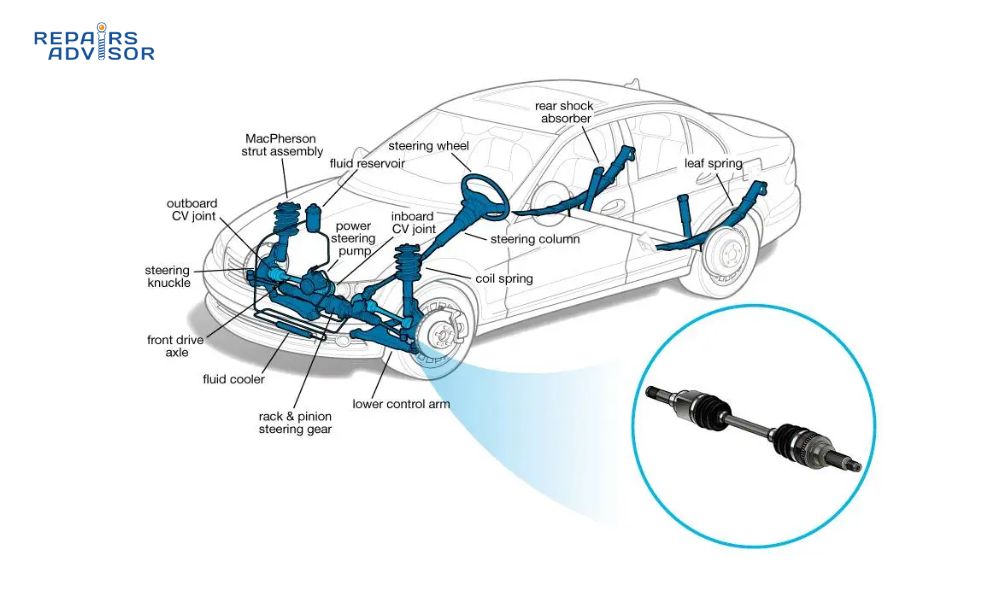A constant velocity (CV) half shaft assembly, also known as a CV axle, plays a crucial role in your vehicle’s drivetrain. It transfers power from the transmission to the wheels, enabling them to turn. Given its constant rotation and flexibility to adapt to varying road conditions, the CV half shaft assembly can wear out over time. Understanding the warning signs of a failing CV half shaft assembly and proper maintenance can help prevent potential breakdowns and costly repairs.

What Does a CV Half Shaft Assembly Do?
The CV half shaft assembly is a vital component of the drivetrain. It consists of a shaft with inner and outer CV joints. These joints, protected by rubber boots filled with lubricating grease, allow for smooth power transfer. The flexible nature of the joints accommodates suspension movement and steering, ensuring consistent power delivery to the wheels.
Symptoms of a Failing CV Half Shaft Assembly
Experiencing any of the following symptoms could indicate a problem with your CV half shaft assembly. It’s crucial to address these issues promptly to avoid further damage and ensure safe driving conditions.
Clicking Sound When Turning
A common symptom of a failing outer CV joint is a clicking noise, particularly during sharp turns at lower speeds. This sound is typically loudest when turning in the opposite direction of the affected joint.
Clunking Sound on Acceleration or Deceleration
A clunking sound during acceleration or sudden deceleration may indicate a problem with the inner CV joint. While other components like the transaxle, differential, or U-joints can also cause similar noises, inspecting the CV joints is essential.
Grease Leakage
The rubber boots protecting the CV joints contain grease. Tears or cracks in these boots can cause grease to leak out, often visible on the inside of the tire, steering, and suspension components, and even on the ground. While a torn boot doesn’t always require replacing the entire CV half shaft assembly, it necessitates immediate attention.
Vibration While Driving
A bent CV half shaft assembly can cause vibrations while driving, which become more pronounced at higher speeds. Investigating the area around the CV half shaft assembly for physical damage is necessary.

Maintenance and Inspection of CV Half Shaft Assemblies
While CV half shaft assemblies are not considered routine maintenance items, regular inspection is vital. Refer to your vehicle’s owner’s manual for specific time and mileage intervals. Ideally, have the CV half shaft assemblies inspected at least annually.
What to Do if You Notice Symptoms
If you experience any of the mentioned symptoms, it is advisable to consult a qualified mechanic promptly. A failing CV half shaft assembly poses a safety risk as it is the final link between the transaxle/differential and the wheels. A broken CV half shaft assembly can damage surrounding parts and render the vehicle immobile.
Inspection and Repair Process
A professional mechanic will inspect the CV half shaft assembly for physical damage, excessive play, and the condition of the protective rubber boots. In some cases, only the boot may need replacement, along with lubricating the CV joint with new grease. However, if there is excessive play in either joint, replacing the entire CV half shaft assembly is often more cost-effective. Replacing CV half shaft assemblies in pairs is not necessary if the other assemblies are in good condition.
Choosing Replacement Parts
When replacing CV half shaft assemblies, opting for factory parts or high-quality aftermarket alternatives is essential. Using inferior parts can lead to premature failure and safety concerns.
Cost of Repair or Replacement
The cost of CV half shaft assembly repair or replacement varies significantly. Factors influencing the cost include the price of parts, labor time, and the number of assemblies needing replacement.
DIY vs. Professional Repair
Replacing CV half shaft assemblies requires expertise in suspension components and access to vehicle-specific repair information. Due to the risk of damaging the transmission or other suspension parts, this task is best left to a professional mechanic.
Conclusion
CV half shaft assemblies are crucial for your vehicle’s operation and safety. Recognizing the signs of a failing assembly and maintaining regular inspections can prevent breakdowns. When issues arise, consulting a professional mechanic for expert diagnosis and repair ensures the longevity and reliability of your vehicle.
| Symptom | Possible Cause | Action Required |
|---|---|---|
| Clicking sound when turning | Failing outer CV joint | Inspect and potentially replace the outer CV joint or assembly |
| Clunking sound on acceleration | Failing inner CV joint | Inspect and potentially replace the inner CV joint or assembly |
| Grease on tire | Torn rubber boot | Replace the boot and regrease the joint |
| Vibration while driving | Bent CV half shaft assembly | Inspect and potentially replace the CV half shaft assembly |
